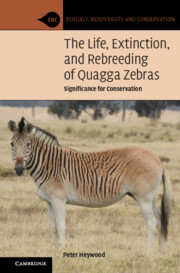Book contents
- The Life, Extinction, and Rebreeding of Quagga Zebras
- Ecology, Biodiversity and Conservation
- The Life, Extinction, and Rebreeding of Quagga Zebras
- Copyright page
- Dedication
- Contents
- Acknowledgments
- Introduction
- 1 Zebras
- 2 Quaggas
- 3 Coat Coloration
- 4 Quaggas, Zebras, and Humans in Southern Africa
- 5 Quaggas Abroad
- 6 Extinction
- 7 Afterlife
- 8 Rebreeding
- 9 Identity and Conservation
- Book part
- Notes
- Bibliography
- Index
3 - Coat Coloration
Published online by Cambridge University Press: 30 April 2022
- The Life, Extinction, and Rebreeding of Quagga Zebras
- Ecology, Biodiversity and Conservation
- The Life, Extinction, and Rebreeding of Quagga Zebras
- Copyright page
- Dedication
- Contents
- Acknowledgments
- Introduction
- 1 Zebras
- 2 Quaggas
- 3 Coat Coloration
- 4 Quaggas, Zebras, and Humans in Southern Africa
- 5 Quaggas Abroad
- 6 Extinction
- 7 Afterlife
- 8 Rebreeding
- 9 Identity and Conservation
- Book part
- Notes
- Bibliography
- Index
Summary
The three zebra species have different striping patterns and individual animals can be recognized by their stripes. The pigment melanin occurs in the hairs of the dark stripes and is absent in the hairs of the white stripes. The body striping is generated at the third week of embryonic development in plains zebras, at 3.5 weeks in mountain zebras, and at 5 weeks in Grévy's zebras. Each body stripe originates from about twenty cells, and so the longer bodies of the five-week-old embryos of Grévy's zebras have more stripes than the shorter bodies of the three-week-old embryos of plains zebras. People have suggested that stripes function in recognition and social bonding, aid thermoregulation, help to camouflage the animals or to confuse their predators, and serve to deter biting flies. Much evidence points to the latter function and this possibility is supported by the fact that quaggas were the most southerly subspecies of plains zebras – living under colder, drier conditions that resulted in fewer biting flies. While this explanation can account for the lesser stripes of quaggas, the reason for their browner coat coloration is not known.
- Type
- Chapter
- Information
- The Life, Extinction, and Rebreeding of Quagga ZebrasSignificance for Conservation, pp. 51 - 59Publisher: Cambridge University PressPrint publication year: 2022

